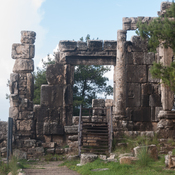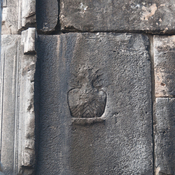Il n'y a pas une annotation en français. Présenté est une annotation en Anglais.
Remains of the Roman road from Sidon to Damascus are partially visible in the river bed. The Al Awali river was known to the Romans as "Bostrenus". It is unclear whether the river is named for Bisri (ancient Bostra?) or Bisri for the river. Note that the river has various names. To the West of Bisri, it is sometimes known as "Joun". About 4km to the east of Bisri, it divides into two parts. Google has both parts as "Awali". Locals may name the northern reach either "Nahr Chouf", or "Nahr el Barouk", and the southern sector, most commonly Nahr el Awali, but also Nahr Aariye (Aliquot offers the spelling Aaray). There are the bases of four granite columns 1m. in diameter at the confluence of the two rivers, and tombs of the Egpytian era.
Note that Bisri is spelled Besri by Google.
I have not visited to confirm. Aliquot has references1.
Références
- ↑Julien Aliquot (2009). La Vie religieuse au Liban sous l'Empire romain: Liban-Sud. Beyrouth : Presses de l’Ifpo, p. 272 Section 38
Remains of the Roman road from Sidon to Damascus are partially visible in the river bed. The Al Awali river was known to the Romans as "Bostrenus". It is unclear whether the river is named for Bisri (ancient Bostra?) or Bisri for the river. Note that the river has various names. To the West of Bisri, it is sometimes known as "Joun". About 4km to the east of Bisri, it divides into two parts. Google has both parts as "Awali". Locals may name the northern reach either "Nahr Chouf", or "Nahr el Barouk", and the southern sector, most commonly Nahr el Awali, but also Nahr Aariye (Aliquot offers the spelling Aaray). There are the bases of four granite columns 1m. in diameter at the confluence of the two rivers, and tombs of the Egpytian era.
Note that Bisri is spelled Besri by Google.
I have not visited to confirm. Aliquot has references1.
Références
- ↑Julien Aliquot (2009). La Vie religieuse au Liban sous l'Empire romain: Liban-Sud. Beyrouth : Presses de l’Ifpo, p. 272 Section 38





